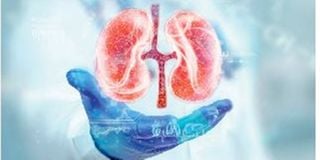Revealed: Kenya's top killer diseases

Kidney failure is Kenya’s most common and highest-paid-for disease, an analysis by the National Hospital Insurance Fund suggests.
Kidney failure is Kenya’s most common and highest-paid-for disease, an analysis by the National Hospital Insurance Fund suggests.
Last year alone, the state-backed insurer remitted Sh2.8 billion and paid for 316,289 patients who underwent renal dialysis procedures. This represents 22 per cent of the total claims, highlighting the growing cases of kidney ailments among Kenyans.
From the report, 406 conditions were reported during the 2021/22 financial year. Renal failure was the most frequent in the period with 22 per cent of the total notifications, followed by delivery at seven per cent, with the Fund paying Sh1.4 billion for the births.
Many deliveries were conducted through Caesarean section, with the Fund remitting over Sh1.2 billion to hospitals for the procedure and Sh506 million to normal delivery amid concerns that hospitals could be pushing women to surgery for financial gain.
CS procedures attracted 41,000 claims and the normal delivery attracted 50,806 claims. The third disease that accounted for the highest payout from the Fund was protozoa disease at a tune of Sh493 million. The common diseases include malaria and toxoplasmosis. Influenza and pneumonia accounted for six per cent of the payout at Sh731 million, oesophagus, stomach and duodenum diseases at Sh471 million, and acute upper respiratory infections at Sh353 million.
Intestinal infections accounted for Sh245 million, hypertensive diseases (Sh366 million), other bacterial diseases (Sh216 million), with persons with potential health hazards related to family and personal history and conditions influencing health accounting for two per cent (Sh581 million).
According to the Fund’s annual report for the last two years, over 623,133 renal failure claims have been paid out, with experts attributing the condition to the surge in lifestyle diseases. NHIF members are entitled to two weekly sessions of dialysis at Sh9,500 each, pushing the annual payment per patient to an average of Sh960,000.
Chronic kidney disease is a growing cause of death and disability. A large number of the cases progress to end-stage failure unnoticed. It is estimated that about four million people, or 10 per cent of the population, are likely to develop kidney diseases in their lifetime. Dialysis purifies a patient’s blood using a machine. It helps keep body fluids and electrolytes balanced when the kidneys no longer function properly.
The procedure balances body fluids by removing waste, extra water and salt and ensuring they do not build up to dangerous levels. According to the NHIF, dialysis is its single-largest medical insurance claim and one of the top expenditure items in the healthcare benefits package. The Fund expressed concern about its cost burden. Earlier, it had announced a cut on renal dialysis payments from the current Sh9,500 to Sh6,000.
Earlier, the Fund had announced a cut on renal dialysis payments from the current Sh9, 500 to Sh6, 000.
This was later stopped by a court order after the patient organisation went to court to stop the reduction.
The Fund sought to reduce the bills for the weekly procedure by Sh1 billion annually to Sh2.7 billion. This did not happen, currently, the Fund is still paying Sh9, 500 for two sessions every week.
NHIF chief executive Peter Kamunyo said a significant number of kidney patients joined the fund after falling ill and they are demanding to get the services.
“The procedure is becoming a burden to us because the Fund is remitting over Sh1 million per year to some patients yet they are paying Sh6,000 annually, they got the cover immediately after being diagnosed,” he said.
Dr Andrew Suleh, a renal expert said the consumption of sugary and junk foods with many Kenyans going slow on exercising has led to increased lifestyle diseases in the country.
“There is an increase in non-communicable diseases that include obesity, diabetes and hypertension. Obesity is linked to lifestyle and we can see there has been a proliferation in consumption of junk and sugary food,” Dr Suleh said
Data from the Ministry of Health show that about four million Kenyans have some form of kidney ailment with the number of people accessing dialysis services increasing to over 500,000 sessions last year, all the 54 renal units countrywide have registered a growing demand.
In 2015, there were only six rental units. This has since grown to 54, but experts say they are still overwhelmed.
High blood pressure (hypertension) and diabetes are the most common causes of kidney disease. High blood pressure, for instance, is reported to cause just over a quarter of all cases of kidney failure.
Numbers started growing in 2016 following the introduction of the Sh2.3 billion kidney dialysis project funded by the government under the Managed Equipment Services (MES) initiative.
Although the MES scheme that started in 2015 has been one of the scandalous projects by the government from how the contract was made to whether Kenyans got the value-for-money proposition for a lot of the equipment, dialysis machines have been a blessing to many Kenyans.
In 2016, the country conducted 18,218 sessions per month, an increase of 100 per cent from 2015. This shot up to 30,155 sessions in 2017 and 60,100 in 2018. In 2019, there were 106,900 sessions.





